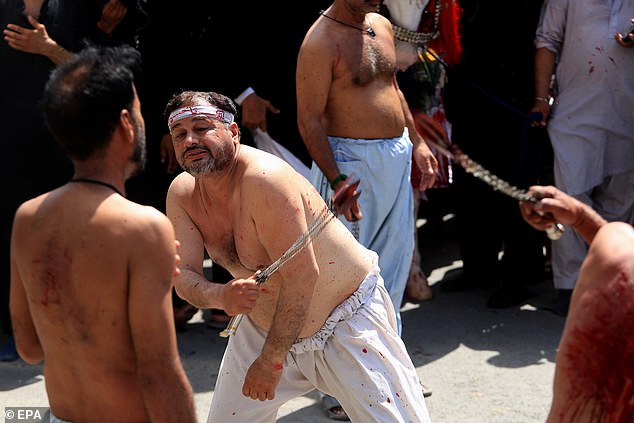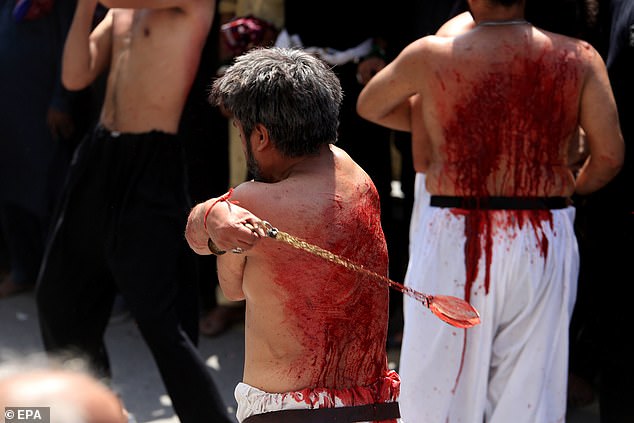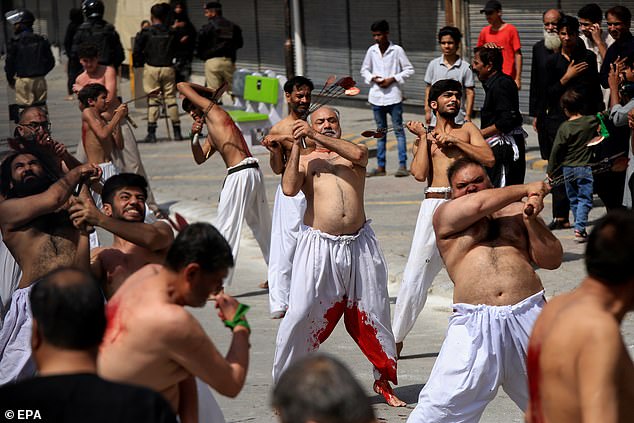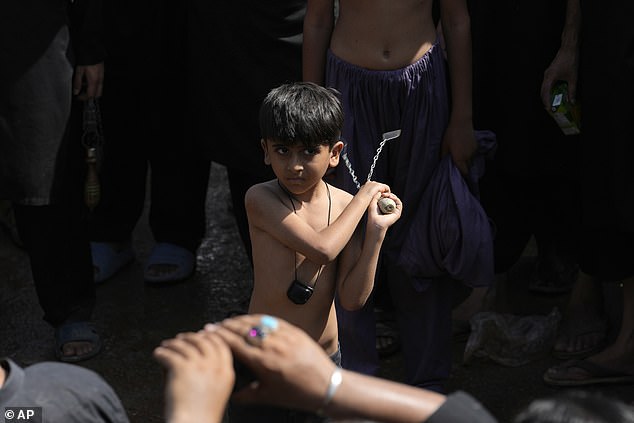Spilling blood for their religion: Shi’ite Muslim devotees whip themselves with sharp blades to mourn the death of Prophet Mohammed’s grandson
Shiite Muslims took to the streets today to commemorate the death of Prophet Muhammad’s grandson, Hussein, by dismembering themselves and whipping themselves with sharp knives to mourn his death.
This holiday, known as the holy day of Ashura, is celebrated by Shia Muslims and commemorates the death of Imam Hussein on the battlefield in the 7th century.
The bloody ceremonies, in which men of all ages cut their scalps or flog themselves with knives attached to chains, are meant to commemorate the violent end of Imam Hussein.
Many believers wear white clothes, which then turn bright red from the blood flowing from head wounds and the flagellation ceremonies.
The beheading of Imam Hussein and the murder of his family were part of a dispute over who should succeed the Prophet Muhammad.
A Shiite Muslim scourges himself on the eve of Ashura processions in Peshawar, Pakistan, on Tuesday

Shiite Muslims celebrate the holy month of Muharram, the highlight of which is the Ashura festival, which commemorates the martyrdom of Imam Hussein, a grandson of the Prophet Muhammad, in the battle for the Iraqi city of Karbala in the seventh century.

During the bloody ceremonies, men of all ages cut their scalps or flog themselves with knives attached to chains.
This conflict eventually led to a bitter split between the Sunnis, who make up about 90 percent of Muslims, and the Shiite branches of Islam.
Every year, many Shiite believers travel from neighboring Iran and other countries to Karbala to visit the shrine of Imam Hussein, located about 80 kilometers southwest of Baghdad, Iraq.
Ashura is celebrated on the tenth day of Muharram, the first month of the Islamic lunar calendar.
Hussein’s martyrdom is widely seen as a symbol of the struggle against injustice and oppression among Shiites.
Ashura is celebrated by Sunnis as a day of penance, during which participants can receive forgiveness for the sins they committed in the previous year.

Many of the worshippers wear white clothes, which are then stained bright red by the blood flowing from head wounds and the flogging ceremonies

Hussein’s martyrdom is widely regarded as a symbol of the struggle against injustice and oppression among Shiites
Tehran and other cities in the country were decorated with symbols of Shiite piety and repentance.
Iranian state television reported that six million Iranian pilgrims traveled to the Iraqi city of Karbala, where Hussein is buried in a shrine with a golden dome, and broadcast live images of the procession.
Many Shiite Muslims in the Middle East took part in the commemoration of Ashura on Tuesday.
This follows a shooting at a Shiite mosque in Muscat, Oman, on Monday night that killed six people and injured dozens, officials said. Al Jazeera.
Video from the scene shows people fleeing near the Imam Ali Mosque as gunfire rings out.

A Shiite Muslim scourges himself during a religious procession on the ninth day of the Islamic month of Muharram, today in Islamabad
According to authorities, four Pakistanis and a police officer were killed and at least 28 others were injured.
The three suspected attackers were also killed by security forces.
The identities of the victims and the shooters have not been released, nor have their motives.
Iran’s Foreign Ministry condemned the attack.
Shiites represent more than 10% of the world’s 1.8 billion Muslims and consider Hussein the rightful successor to the Prophet Muhammad.
Hussein’s death in a battle against Sunnis in Karbala, south of Baghdad, created a deep rift within Islam and continues to play a major role in shaping Shiite identity to this day.

It is believed that 6 million Iranian pilgrims have traveled to the Iraqi city of Karbala, where Hussein is buried

A Shiite Muslim boy holds a knife attached to chains during a Muharram procession in Islamabad, Pakistan today
